WILDLIFE AND OTHER ANIMALS IN SOUTH AFRICA & SCOTLAND
We have lived in Scotland now for well over two decades and have had the privilege of having great views of the distant Highlands with a variety of wildlife roaming through the garden. Deer, sqirrels, rabbits and others. South Africa seems further away in time with it the wilder animals, birds, reptiles and bugs being just memories. But it is fun to look back on that period.
I have a comprehensive collection of photos from the Namibia trip with my wife in the 2000s on my hard drive - very much better pics, but the older ones bring back other memories.
These ramblings are my own outlook on life. My formative years in particular.
So let's go to my formative years.
Wildlife in my childhood
As a young child we lived just up the road from virgin bushveld inhabited by birds. And snakes. And vagrants. We played down there a lot. Somehow imbued with a safety felt by my Christian Science keen parents. And out ignorance.
But I did glean some sense of the natural world which lasted all my life. I learnt to read fairly late as a child, but my mother sensed this interest in nature and got me library books on fictitious hidden African kingdoms and about birds, otters and other creatures. They got me reading more on my own. One was about the excitement of finding Avocets on a nearby pond in England. We don't have avocets up here in Scotland. We didn't have any in South Africa. But that bird (which I have only glimpsed briefly once) still instills in me a love of birds. And it is the emblem of the RSPB.
While at Stirling Primary School I would wander into the marshy pond behind the old age home across the road. Red Bishop Birds nested there. Extraordindary birds. Then one day a bulldozer moved in. I was devastated. The birds were devastated. I wrote a letter of complaint to the Daily Dispatch.
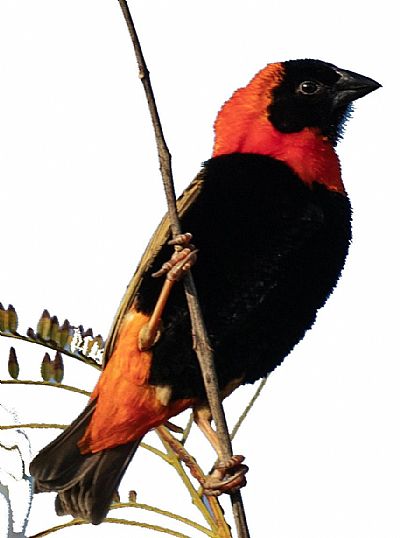 Google image
Google image
As a scout out hiking I was thrilled to come across a secretary bird near the Gonubie Bird Reserve. I got to know every drongo and paradise flycatcher across from our Selborne house personally.
As a teen I would set off by bike or on foot from out Selborne house down the road to the bush now occupied by Selborne Primary School. I had around my neck my father's old army binoculars and the chunky copy of Roberts Birds. The decayed strap was replaced by string. I was thrilled to see a crimson shrike down there. I knew it should not have been there as they are only found in the far off drier areas of the country. But there it was.
As little kids we enjoyed playing with magnifying glasses. Under a hot African sky that invariably includes not only looking at bugs too, but burning stuff. And we were to find that ants explode if you burn them in the white hot dot of a magnifying glass. Something that in the retrospect of time now seems rather disgusting..
Fur
Perhaps the first animals I came across were dead and worn. As a very young child I found the soft fur of my maternal grandmother, Nana's stole irresistable. She also had a silk lined fur muff. A tube of fur or other material in which to place your hands when cold. The stole was certainly fox - it still had its small beady-eyed face and a lovely tail.
Movements to use birds and mammals for fashion had started a long time before this, but it was nevertheless a long time too to gain acceptance.
As I child we played cowboys and Indians with cap guns and bows and arrows. I became aware of the fur hats of some of the heroes such as Davy Crockett in cowboy stories. So my maternal granny made me one out of an old fox stole. It eventually simply disintegrated.
Wilder wildlife
As small kids we often came across snakes in the bush and sometimes monkeys. When we moved from Baysville to Nahoon Mouth, I at 10, my brother two years younger, we came across dassies which would come up the street drains to sun themselves on the kerbs or even the low garden wall. I tell of our story of a leguaan (large monitor lizard) coming into our house and up the chimney in my section on Growing Up. And we were to see several along the Nahoon River embankment. I remember a close encounter with a large one disturbed by my dog Jet. It rush past me and up a prickly euphobia tree.

This is a pic of a leguan in the zoo. As the one captured at ourhouse was taken there, we like to imagine that this is ours.
Little Big Game Hunter
My paternal grandmother was friendly with Poppie Hart and his wife who had a farm, Happy Valley beyond the Hogsback area. She would visit for a few days every so often and we would take her there.
Poppie was a one-time big game hunter, the type from adventure stories. His large farm house was a veritable museum and stuffed with stuffed animals of every description from around the planet. I remember the large tiger skin complete with growling head across the floor. A sumatran rhino stood forlornly at one side. Massai assegais stood starkly against the bay window.
By the time I met he was profoundly deaf and would require frequent use of a hearing tube.
Each time we went up he would tell me that when I turned 12 years old I could hunt a springbok. The day duly arrived. I was very apprehensive, having never been one really OK with the idea of hunting. But when he saw me again, he expressed doubt that I could hold a rifle, let alone take aim, pull the trigger and take the recoil. I sheepishly, but thankfully slunk deeper into the back of the bakkie.
But if not me then my father needed to shoot the animal. He was horrified, but was cajoled into taking over. A male was selected. This was a lone male, a ram and it was time to cull the numbers anyway. Bang. An animal on the ridge went down. But it was the wrong animal. A female. A ewe potentially of breeding age.
"Trackers" (farm labourers) were sent to retrieve them. So now we had two springbok carcasses instead of the intended one. The carcass was butchered by them too, some kept by them as a reward and some wrapped up for us to take home (note, not as yet cured). And we were given the skins and one set of horns.
My brother and I attempted to cure the skins, by extensive and intensive scraping and rubbing in of coarse salt. It sort of worked. We each had a springbok skin next to our beds for years. One had a hole in it from the shot to the shoulder. The dog took a great interest in them. But they inevitably got too smelly and were thrown out.
Our father mounted the pair of horns on shaped wood wrapped in red felt. Unlike antlers, antelope horns are hard skin over a bone structure. We were not given the forehead bone so the horn outer layer had to be fixed by other means and they never did look quite straight.
The aquarium
My father had been involved in the redesign of the aquarium as a city architect. He had go to know the person running it and was able to take us behind the scenes to the smelly cold sides of the fishtanks not usually seen. We were also able to feed the penguins, although I think the public often were. And on rare ocassions were were able to feed the seals too.
These were a pair of lumbering big Cape fur seals that just lay about a lot. There was a sealion for a while too which they tried to teach tricks to, but it was rather outdone by the larger seals.
The seal tank was a large rectangular enclosure right on the shore rocks with wide heavy walls with a small rock island in the centre. One of the seals had found out that a fast rushing swim up vertically could take him out onto the wall. He was shooed back a few times, but eventually made good his bid for freedom.
I once saw a wild sealion on the rocks and also a penguin once too, on both ocassions probably confused by wild weather and currents as they did not usually occur as far up the coast as this.
The aquarium would restock and evidently also survey local estuaries sometimes and we would watch a range of fish come ashore. I used to take a schoolfriend out on the Naoon River in a borrowed Scout rowing boat. I remember the grunter jumping one warm summer day and we were both hit in the face by these jumping fish. They really do grunt, something that I have learnt that they do with their teeth.
The sea
As kids we would spend happy hours trying catch muddies in the rock pools with small nets. Sometimes we succeeded and then it was the problem of what to do with them. Some lived for a while in the murky water of an old Belfast sink in our Nahoon garden rockery.
When I got into paddle skiing as a student and later also windsurfing I encountered about 5 sharks in the 5 years that I did it regularly. On one occasion while still a student I came across a Southern Right Whale while out on my paddle ski in Algoa Bay (Port Elizabeth). I correctly kept some distance and was furious when the next day there was a picture of someone actually swimming with it. Dolphins were a common occurrence. The first one I ever met actually bumped my ski in shallow water while upside down. An average size of a dolphin pod is about 15 individuals. Larger groups are probably two pods together. There is always one that seems allocated to come over to size you up. It was amazing to actually catch waves with them or see them jump for sheer joy.
My student digs were for a while in a boarding house right on the beach front. Very close to the museum with its adjoining snake park and tropical house. Great for jogging, swimming or paddle skiiing. One evening I found a crowned crane on the esplanade. It evidently had clipped wings, but was trying to fly. With some help I caught it. Presuming that it had escaped from museum complex and knowing roughly which enclosures had snakes, crocodiles, meerkats or birds, I dropped it over the wall. I really hope that I got that right. When I mentioned the escapade to the staff, they had not noticed anything amiss. It was also while living there that I once came across a cormorant dangling upside down from the large steel girders of the old Humewood slipway. It had become entangled in fishing line. borrowed some scissors from the life guard first aid box and paddled across, tied up my paddle ski and climbed the girders to free it.
Our first architectural school premises were behind the science block on the hill in central Port Elizabeth. Live penguins were kept in chillers like large fridges. Sometimes they got out and once some got as far as the city centre on their bid for freedom to the harbour. The modern campus actually had some springbok and blesbok in an area on its outskirts. I used to like to go off to Cape Recife just beyond the campus to look at the birds and walk along the shore. There were frequently vervet monkeys there. One day I came across a very large bedraggled baboon walking down the road. It is many miles between here and the mountains. It is anyone's guess what it was doing here.
Cats
When my future wife and I first moved into a house together it was a rented one in Gonubie, almost on the shore. I had been on the Border Historical Society committee and used to have meetings in the evenings in the hall behind the museum. A lovely cat had been living on the premises from catching mice and hand-outs and it used to join us at the meetings. No one knew where it came from so I took it home. It settled in well and got called Youdi after a previous cat in Scotland. Before we committed ourselves to each other, we each decided to go on trips of a week or more separately. and Youdi was taken to kennels some distance away. Youdi had other ideas about such a place and made a break for freedom promptly disappearing. A week later she appeared at the house a little hungry, but little the worse for wear, the relative looking after the house somewhat perplexed. She had found her way unaided over about 8 kilometres of farmland, bushveld, a main road and suburbs. It wasn't that long after that that we found that she was pregnant. She had 6 kittens in a box under the bed. The whole family used to follow me for walks to the rocky beach. A giant sand box. The growing kittens were either taken with us to our new home or given to acquaintances.
Very obviously, with commitment to us by our faithful cat, we were duly engaged and married, committing ourselves to each other for life.
Our new house in Beacon Bay was surrounded on three sides by bush. Below it was the Quinera River leading down to Bonza Bay Beach. I could paddle down to the sea and took the girls when young on my larger ski or our canoe. There was an island opposite the house. On such a paddle with S we came across a very large leguaan almost vertical on the steep bank sunny itself. An awe inspiring sight.
One of our cats here also had kittens in a large box. I assisted in their births. Not all survived. Some disappeared and we suspect were the victims of snakes or other wildlife.
Of the cats that we had here, the black cat Paddy, was the most attentive to me. He would follow me down to the river when I went on the paddle ski or in the canoe and whine out of concern. I started to take him out in the canoe for short excursions. Really short, really. But that seemed to assure him that I was fine out on the river.
One day I was down there getting the canoe set up when he climbed up a small branch overhaning the water next to me. There was a sudden soft whoosh and as I looked up a large eagle had swooped down at him just over my shoulder. But the eagle, possibly a long crested eagle, could not catch him within the vegetation along the branch and he escaped unscathed. It all took just seconds.
Snakes
I saw really tiny snakes in the dry dust of the pavement at our our Selborne house and elsewhere. They are so small that they look like pencil lead that has become alive as if under the spell of a wizard. They are so small that if they were to bite you they could only grab the skin of your finger prints. Really minute. They could be found under stones in the dust where they would seek out the larvae of insects. If picked up, they may initially play dead, but if provoked then wriggle furiously on your hand until dropped.
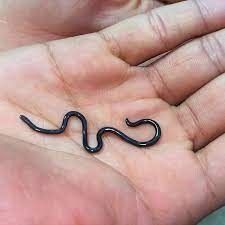
Google image.
Snakes were common. I had come across a large mole snake while surveying our site (years before building on it). I scrambled onto a termite mound holding the survey staff until it had gone. They are not actually venomous, but can still be dangerous. One of our office staff members collected snakes. He had been bitten by a "pet" mole snake and got a terrible infection, the bite, not though having venom, still went septic.
Most snakes found were non-poisonous grass snakes or small night adders which are poisonous, but not much of a problem.
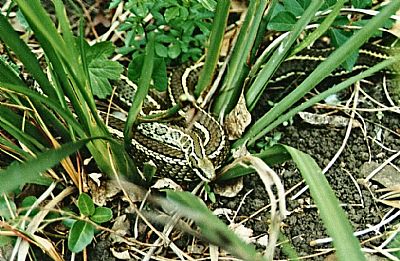
A beautiful spotted grass snake. Grass snakes are not usually venomous, but this one is an exception. However its venom is of little potency.
We had our weeding woman work around the rose garden in front of the dining room. (Many households had such part time staff besides a maid and a gardener). She complained one day of being bitten by a snake there. I had only seen earthworms there and as she had not wounds simply laughed it off. But when she returned a week later her hand was very swollen and bandaged. I was to later find an innoccuous little snake there and identified it as a side toothed species that was too small to really bite, but could inflict a serious scratch with a light venom.
When we extended the house another large one was found sunning itself in amongst the disused scaffolding. This is the snake that gives me the most heebies. I tried to kill it with unknown results as it slunk in deeper. The only time I have ever tried such a thing. It actually walks on its rippling ribs. It will not slink off when you approach as other snakes, but lies there until you stumble on it. Puff adders are not lethal to humans although I knew of people who had been bitten suffering terribly for a long time. I am not sure about the effect on smaller children and was very nervous about them. I once saw one on the path down to the river while carrying S on my shoulder.Fortunately we grew a 6th sense about dangers such as these. There is a notable difference about instinctive self preserving caution when you live in South Africa and safe Scotland. That instinct dries up when you live in the UK where the scariest threat is midges.

A puff adder in the scrapped scaffolding planks in the garden.
Our "little" snakes pale compared to those our cousins in Zimbabwe encounter on a regular basis. Look at this mamba killed on the farm in 2025. It was thought have been responsible for the demise of some dogs. Not that long afterwards, its mate of a similar size was also found and killed.
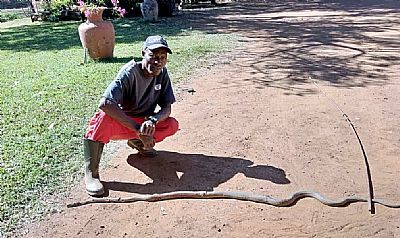
One of the two mambas in Zimbabwe. I have seen one cross a road at high speed in Namibia. Awesome.
Cuter wildlife
We did not have dassies living in our street drain pipes near our house although there were colonies in nearby streets and also in the rocks across the river. One day I had to go to our parents' house in Selborne to pick up something. A round trip of about 50 minutes. On returning I could sense that something was amiss with the engine. I opened the bonnet to find a large dassie steaming away very uncomfortably in amongst the hot engine parts. Its initial reaction on seeing me was to wriggle in deeper, but when I eventually got it out it seemed subdued but able to lope off.

One of several dassies coming up the storm water drains in Beacon Bay for a handout of bread and apples.

Vervet monkeys frolicked in the trees across the river, but only in later years found themselves on our side. Some visited our garden and bounded over the roof. The girls threw them fruit. They don't like garlic!

A vervet monkey on the verandah.
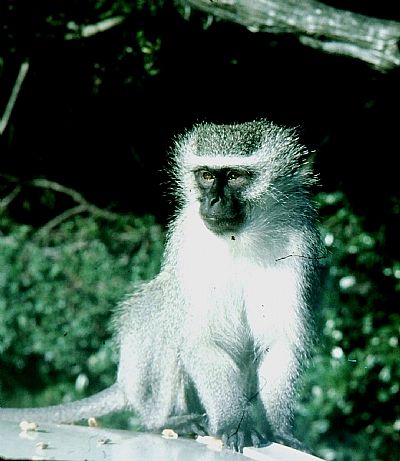
This monkey was one of group attracted to visiting cars by hand-outs of oranges, bisuits etc.
These are vervet monkeys. We would see samango monkeys in such places as the Hogsback Mountain resort, but they are less inclined to hand around people. vervet monkeys as this one can get quite cheeky. We were sitting at a pre-school outdoor event at Nahoon Mouth once when one came down from the trees and stole a peach from the hands of one of the mums. They frequent much of the coastal forests and can be found through most of the country.
We used to have the double doors of the lounge wide open on summer evenings. One such evening we had an Egyptian Bat come in and cling to the curtains. Then I realised that David Attenborough was on tv talking about bats. It is just possible that it had heard the bat calls on tv and come in to investigate. The large fruit bat was fairly common too. It would leave ghastly purple faeces on the gable wall though. While a fruit eater, hence the colour of its droppings, it seemed to join the other species for an odd insect attracted to the house lights. Another amazing nocturnal visitor was a Lesser Spotted Genet. A gorgeous animal. It sat up on the curtain rail for a while. We never cleaned off its little footprints. While we were to see small buck sometimes they were never common near the house. There was probably a lot more going on than we realised. The large termite mounds below the house could show signs of excavations presumably by something eating them. And they also served as territorial marker points, shown by the faeces on the top, by such creatures as genet. While we never saw one, porcupines were evident by their dropped quills. Our paw paw tree was just about knee high when it was felled by a porcupine nibbling the soft stem. The clue of the culprit by a quill.

A tortoise pays us a visit.
When I went in the canoe or paddle skiing on the river, my cat Paddy would come down and express great concern about me going on the water. He would stay at the waters edge and yowl. So I took to have him in the canoe with me for a while. He didn't really like this, but after a few minutes I could let him out fairly satisfied that I was alright. One day I was just setting off again after a brief jaunt with him when he had clambered out on a small branch over the water. All of a sudden a large woosh of wings appeared from nowhere and dived at him right next to me. The dense branches stopped the bird and it flew off – an African crowned eagle otherwise known as crowned hawk-eagle with an enormous wingspan. We had a great variety of birds in or visible from the garden from sunbirds to spoonbills. Over 80 different species.
As a keen member of the Wildlife and Environment Society of South Africa, I was to hear of many more species in the vicinity than I was to see. One was bush pig. A strange but enjoyable time was spent at the invitation of the regional Environmental Department – at night – in the zoo. Lions roaring in the dark. The braai (BBQ) glowing. A bush pig on the spit. One of the best braais I have ever had. And possibly the last. The family drifted towards vegetarianism and any braais we have now are meatless or with fish.
The Environmental Department stocked the catchment area around a small reservoir within the greater East London city boundaries adjoining some industry, with game. We had some great walks there. I have a firm memory (but a missed photo) of a little Sarah wandering off down a freshly mowed area within the bush veld. A herd of zebra came passed and peered at her. On another occasion at the Gonubie Bird Reserve she wandered off to look at the crowned cranes. One came bounding over to her agitated and with its wings wide open. Almost her own height. Perhaps Sarah had these two experiences due to her size. But she had another strange experience at home in her bedroom.
When we extended the house, each girl got her own room. Sarah had some pot plants in her bedroom. Somehow a large frog had got in and made itself at home in the plant pot. I removed it to the garden. It came back. I took it down the road. It came back. I took it further. We were watching tv one evening when we heard it croaking in the dining room somewhere under the dresser. Over a few days it had found its way back to Sarah's plant pot. I took it even further away. I won.

The resident frog in the bedroom.
We could find the small white frogs specific to white arum lilies in the Gonubie Reserve. In our garden we had bromeliads. These nearly always had rain water in them. A brilliant place for small frogs.
A profusion of bugs
The term "bug" covers a broad range of creepy crawly things. I used to be able to lie on the Beacon Bay lawn and watch them close up. If I stretch out my fingers, index and thumbs together to form an open circle, and invariably be able to county 12 bugs of different types.
Most of those that we could get close to this way were ants and small spiders. Sometimes we could see large wasps catch and immobilise with its venom, very large spiders very much larger than itself. These would be dragged across the lawn with some effort and then down into their burrows.
Such wasps could have burrows with spun lids. Others built bottle-like homes from mud. There are quite a few different types of wasps of this type.

A google image of such a wasp - about actual size if seen on a laptop screen.
"Bugs" does not necessarily equate for "pests". The former can be fascinating to watch and great to have around. The latter are really those that have a detrimental affect on us, biting us, gnawing our woodwork or simply being very irritating.
Pests
So much for the picturesque. What about insects and other bugs? Scotland has midges. South Africa has mosquitoes. We had just moved into our new bedroom and had the windows wide open due to the smell of paint and it was a warm evening anyway. Zillions of mosquitoes came in. Many settled on the ceiling. I rushed around wacking them with rolled up Daily Dispatches. A bad move. We had both squished mozzies and marks from newsprint all over our new ceiling.
And spiders. The flat ones were common, platties, and could be chased around the walls which really irritated them, but we never harmed them. Huge hairy tarantula looking spiders scared me, not so much for myself, but for the girls. Spider bites could be serious. Some call these baboon spiders. The only one I ever killed was one that insisted on hanging about above the baby cot. They are not really aggressive, but I wasn't taking chances. We had a large nest of hornets in the tree near the front door. I would remove them with a long extension on the long extension on the vacuum cleaner; sprints for safe between sorties until they calmed down again before next attempt.
There were various types of wasps. The potter wasp that built conical clay nests and those that lived underground. The latter is but one of those that is absolutely enormous. One Christmas morning one took a dislike to Ines and stung her on her arm. Perhaps due to her perfume. The little C, still anout 3 years old came out and got a sting from the very same wasp on her nose. It swelled up badly but Christmas was still enjoyed. These same wasps like to kill the large hairy baboon spiders.
By contrast, hornets were smaller, but could be found in social nests. We had a scew pine tree outside the front door and there were large two papery nests there full of them. As we didn't want a repeat of the wasp stings, I endeavoured to remove them. This was done with our vacuum cleaner with old extension pipes added to the current ones to form a fairly long weapon. I would turn on the vacuum and try to remove as many as possible. That took several attempts with hasty scampering by me for safety indoors. But it did work. There were sad thuds down the vacuum cleaner as each was sucked in. I then sprayed insecticide down the vacuum for confirmation of their demise.
EVERYBODY has cockroaches in South Africa. They love damp conditions. They can congregate in their hundreds. Control of them at the back of kitchen cupboards from whence they emerge to tackle anything left around is an ongoing battle. Every type of deterrent and killer is bought and tried with limited success – just until they become used to it. And then you try something else. When you can't cope any more, who ya gonna call? ROACHBUSTERS!! Of course. When we resorted to them, a large black van appeared with a large cockroach model on the roof. All very dramatic. Every neighbour knew we had cockroaches. But not one made a derogatory remark. They all knew the deal.
The bigger game
These are experiences around the house or where I windsurfed or paddle skied. The ocassional shark fin appearing. Great memories of being amongst dolphins when out on the waves.
I also have some other amazing mental images of wildlife encounters. Ones that on the whole never became photographs.
When I was about 10 we went to Hluhluwe Game Reserve. A guide took us down a slope on foot to find a white rhino. We found one with a calf and he calmly herded it with a stick to pose for us. Then there was shouting from somewhere near the car. Another group of people had disturbed a black rhino and our group had to make a hurried detour back to the car. When we went to the Kruger National Park we went all the way to the northern border. It was getting late one evening when we got surrounded by a great many buffalo. We nervously eventually got clear of them, but we then came across two bull elephants fight right in the middle of the road over a cow. We just had to wait it out. My brother and I were under the back seats. It was by now past the time when the camp gates were locked and latecomers could be fined. We were reassured by the several car lights up ahead. But they turned out to be the eyes of impala reflecting our own headlights. We crept back to the closed gate of the camp and had to attract attention to be let in and my father had to plead not to be fined.
I have described the baboons on the roof of our honeymoon cottage at Loteni in the Drakensberg Mountains elsewhere.
On a visit to the Mountain Zebra National Park as a student Chris and I did a hike. We saw many zebra and black wildebeest galloped past. Dangerous beasts such as rhino had not yet been introduced, but illusive leopard were known to inhabit the higher koppies. We were sitting in a dry river bed having refreshments when rather close to us came the loud umph, umph, awrrrrr, from a clump of thorn trees and reeds. Our immediate thought was of leopard. But deciding that that was not likely down here we approached. Two enormous tortoises were making love. We decided that they needed their privacy.

The mountain zebra in the park. (lighter build than the Burchell's zebra)
When we had established the local branch of the Wildlife Society one of our outings was a weekend in the same Mountain Zebra National Park. It had been extended with the addition of some farmland. To our horror we found several snares. But I have a wonderful memory of jogging along the track in the early cold misty morning – a large eland bull calmly jogging parallel to me not far away in the dip to the side. We were to see eland in a mystical setting as a family years later. We had just arrived for a weekend at a holiday cottage on the Wild Coast. As we approached the road bent towards the beach and about 6 or 7 eland were trotting in the mist along the sand next to the surf. Magical. Of course we had monkeys on the roof at breakfast time.

An eland taken in the Zebra Park,

I took this picture of an elephant in the Addo reserve while I was a student.

This young elephant did a mock charge on our open vehicle at Mpngo Park near East London. It was one of a group evidently hand reared and so used to humans.
We were to have some other large animal encounters in such places as Etosha, the Pilansberg reserve and even more locally in the smaller reserves near East London.

This a younger me at the Shamwari Game Reserve with a lion cub. Really like holding a golden labrador, but this cub was used to being handled and was probably more complacent.

Its dad was even more impressive even when seen from a closed vehicle.

A rhino mother and calf seen from an open vehicle in the Pilansberg reserve. Such impressive horns are sadly now extremely rare, often cut short to deter poachers.
Private game farms are to be found widely in SA. I remember visiting that of the Burchell's farm near East London. (Descended from the famous Burchell after whom zebra and shrikes were named. Besides being harassed by Blue Cranes in their gardens, I remember the younger members of the family taunting captive lions behind a tall mesh fence until they charged at us. Their father was into producing Christian tracts.
Game on farms was either for the owners own supplies for venison, but sometimes as a commercial concern for hunters, often rich foreigners.
Ostrich farming became big business during the fashion rage for feathers in Europe and America. Now it is a shadow of that and depends on tourism as well as selling ostrich meat. Not bad if cooked well and with sufficient sauce, but not really that popular.

So here I am riding an ostrich, my knees firmly over its large wings. The attendant didn't trust me coping on my own so held on too. You can really steer an ostrich by holding its neck.
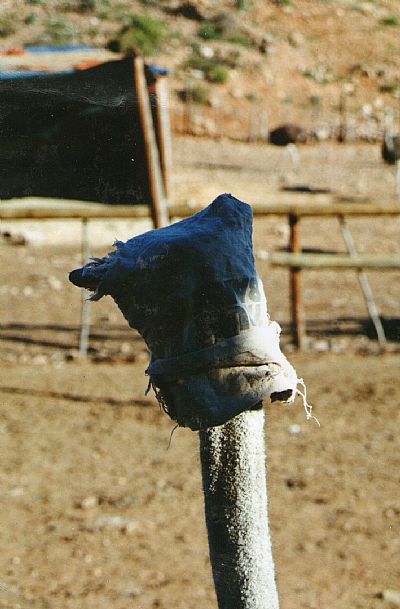
Ostriches may have a long neck, but a small brain. A sack over the head means no threat visible and they calm down immediately.
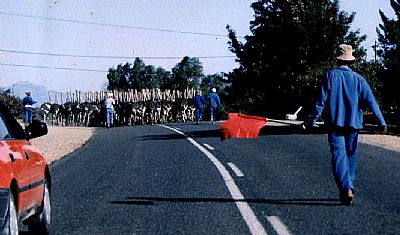
Herding ostriches near Oudtshoorn.
Baboons
Fortunately we didn't live within an area frequented by by baboons. They can be very troublesome and sometimes vicious. An adult baboon can kill a leopard. I had some encounters with baboons.
One of the couples known from church kept a baboon in a small enclosure in Vincent. It probably had its canine teeth removed, but I kept my distance on the very few visits there.
I mention the time a young baboon sat on my shoulder at the circus when encamped up the road in Selborne here FAIRS AND CIRCUSES
And I met an extremely large one when driving down the road to Cape Receife near the university of Port Elizabeth one rainy day. How it got there or why is a mystery.
Cape Point and such areas are of course renowned for baboons.

Here is one on my father's car in the Cape Point area.
Our honeymoon was wet, but very romantic. Having needed to alter plans due to the heavy rains we had not booked ahead for the places that we were to end up at. Yet we were to find outselves in a remote cottage within the Loteni Nature Reserve. Alone. Except for a large group of baboons passing by in the evening. With some clumping over the roof.
Crocodiles
Crocodiles seem to become big business for a while. Crocodile skins for export and some income from visitors. We had two such crocodile farms near East London. There were reports of some inmates escaping into the rivers when heavy rains flooded their pens.

Crocodile farming also became popular, mainly for the sale of their skins, but also a bit of tourism. This was taken at Doc's Crocs near East London. That is the owner and his daughter handling a small one. You need to check all your fingers.
The zoo
The Queen's Park zoo in East London played a central role in much of our lives. In the early days the road between the upper part of the city centre ran right through it to the harbour. We would often take this route on family drives and stop off for a peek at the swans or monkeys.
On one occassion I was trying to feed peanuts to a monkey through the bars of a cage when it nipped my fingers. Eina!, But not real injury. Monkey bites can be viscious.
My father designed the lion enclosure while still with the Council. I was privileged to have been able to walk around inside it - before the lions were introduced. But I also got to see where guinea pigs were bred in the back.....meals for various carnivorous residents.
I got to know the zoo director in later years, (not the one who removed the leguaan from our chimney), seeing him walk in with young, but fully grown lions in a more basic enclosure. He would rear lion cubs and such like at home so had a good relationship with them.
There was some consternation one year when the small, but well stocked snake house burnt down. There was no sign of the python.
There was something quite casual about safety in those days. (I don't know if much has changed since then). Enclosures were not really condusive to animal comfort either. Many were much too small. Many animals paced back and forth alarmingly. The African lynxes were always extremely vicious, cramped as they were in a very tiny space. The leopard had a sound purpose made enclosure, but it too was very limited. The public would go right up to the upper corners. One leopard took to the habit of jumping up onto the ledge against that mesh and we heard that one day someone had stuck his had through and had his arm badly ripped.
Besides the formal lion enclosure there were tigers and other big cats in larger, but not as robust enclosures on the edge of the zoo. That was more pleasant for them being surrounded by forest. Just beyond that was the road up from the harbour. Some idiot deciding to take a short cut from there through to the town centre climbed the high fence... and met his end.
Of some embarassment to many of the city residents was Jackie the Bear. He lived in a purpose-made bear pit. Although he did have a partner for some years, the relationship did not go well. There were regular fund raising events to try to improve his lot, but he lived a miserable existence down there.
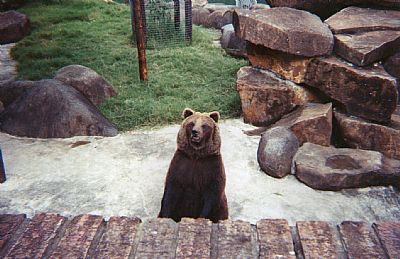
Not much of a life for a bear.
I mention these examples as it raises the questions, often asked, as to what a zoo should and shouldn't be. Is it just to somewhere to entertain the children or to educate the community? Or should it be there to protect endangered species? If the latter, then surely people need to be kept at a distance. East London's zoo has a valid role, but remains poorly defined and questionable.
Our Scottish wildlife
These days in Scotland we look over a field with cows at Ben Lomond. A carrion crow visits regularly for a hand-out and a cock pheasant did too until recently. I actually managed to hand feed the pheasant sometimes and just occasionally both he and Sushi the cat would come up to the car when I came home. Or he would follow me around the garden. His long tail would sometimes get broken or sparse as the crow would pull it in competition over the fat balls I throw out to them, He had introduced two hens. In the spring we had a brief visit by 10 tiny chicks. By the autumns there was no large cock, but the two hens, sometimes three, still came. And then we noticed two young cocks and a hen. Were they chicks grown up fast? The mystery thickens as then three hens came. And then a cock and a hen. A wide variety of birds come to the feeder. Sometimes even a jay or a woodpecker.

The pheasant cock awaits a handout in the snow. In this weather he fluffs himself up and looks even larger – and fatter – than he really is.

The pheasant cock and Sushi the cat greet me at the driveway as I arrive home.

Some of the 10 pheasant chicks in the summer. By the winter those that survived had grown up and visited again.
The pheasants outside the kitchen window or in the garden have changed over the years. We can go for ages without one then another appears. They have either been born in captivity (for the pot or game shooting?) or have some innate inherited instinct from earlier generations of this. Those that pitch up recognise us as a feeding opportunity and hang about, presumably also smelling the fat balls in the feeders meant for smaller birds. We then throw some balls over the wall and they stay.
Some though seem very happy with direct contact. The hen below came into the kitchen for hand outs and we had another pale cock (variations in plumage are common) that I could hand feed - until the resident cock had a fight with him and saw him off.

A pheasant hen in the kitchen.
We regularly see roe deer in the field or in the garden. They have a fairly set route around us and through the woods. Charming creatures and always a thrill to encounter. We have seen the occasional one hit by a car and I had the horrible experience of helping the SPCA put one down. A sad but strangely intimate experience.

A young deer in the garden.
Sushi, the cat, sometimes catches birds and mice and brings them inside to either play with or eat. We have had many a mouse scurrying around the lounge or kitchen. Even a rat in the piano. This is getting less frequent as she gets older. Rabbits, bunnies, were common around the field and garden until a local “hunter” got rid of them- by hand. But Sushi needs to take a lot of the responsibility. She would catch them while young and we would find just the head of a bunny in the kitchen. Yet I did manage to rescue many a mouse or bunny and release further away. As with mice, Sushi would sometimes bring a bunny inside almost unharmed and play with it. One day Nessie was sitting in the lounge watching tv when she exclaimed to me – was that a rabbit that just went past? We may be lucky to see a mad hare romping haphazardly around the field in spring. Quite an entertaining sight.
We sometimes get grey squirrels. Almost as on cue, one has just run up the back garden as I write this. Greys are an introduced species (unlike the cuter smaller reds) and came from America. But rabbits were introduced too – by the Romans – for food. It is possible that the hare was too. And of course so were the pheasants. It is possible that they too were introduced by the Romans and perhaps reintroduced in Victorian times as game birds and are bred. This may explain why they hang around people. Not bright enough to realise their personal danger, but used to people and handouts.
Over a day or two we once saw a weasel peek at us over the garden wall. Of course Sushi had to catch it and bring it inside. In trying to get it out again I had the experience of it scrambling up my leg. I did manage to get it out before some embarrassing injuring to me and it disappeared into the undergrowth.
Foxes have passed by a few times. They are not nearly as common in the countryside as in the city. On one occasion Sushi the cat chased one off. Then just the other day a young fox trotted past amongst the cows. Two calves decided it was worth investigating and perhaps playing with and bounded over. That was too much for the fox,

A fox from the kitchen window.
When I worked in Glasgow I would taken early walks before work and often saw foxes. One once ran right past me carrying a squirrel. On another occasion when I worked for architects within the science park, I heard crying like a baby. As there was a university residence there too, I thought it was a student playing the fool. And then a limping fox came and stood right beside me, using me as a shield from an aggressive competing fox nearby. And once when I was about to go on a site visit to a school project in Musselburgh, I saw a fox being shooed out of a town house kitchen by a woman with a broom. It evidently had entered through the front door on the other side and passed right through looking for food.

